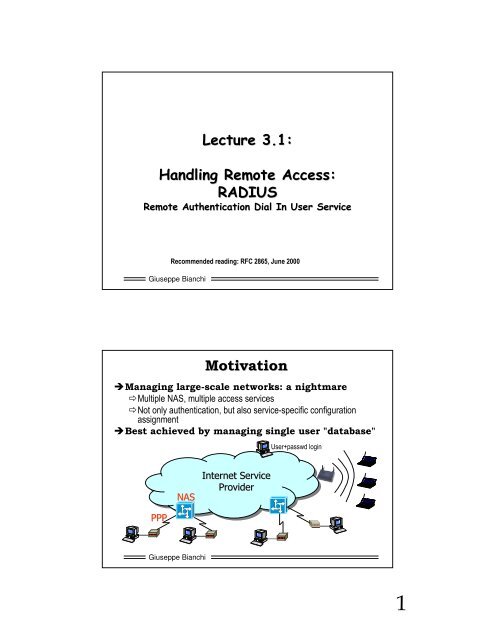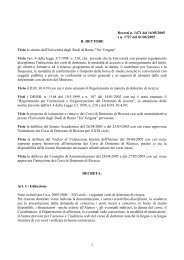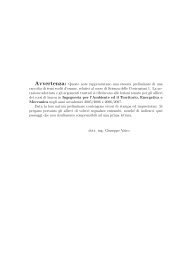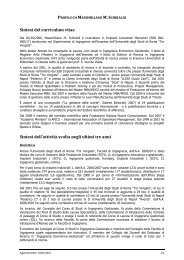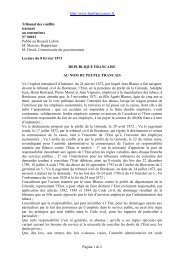Lecture 3.1: Handling Remote Access: RADIUS Motivation
Lecture 3.1: Handling Remote Access: RADIUS Motivation
Lecture 3.1: Handling Remote Access: RADIUS Motivation
You also want an ePaper? Increase the reach of your titles
YUMPU automatically turns print PDFs into web optimized ePapers that Google loves.
Giuseppe Bianchi<br />
<strong>Lecture</strong> <strong>3.1</strong>:<br />
<strong>Handling</strong> <strong>Remote</strong> <strong>Access</strong>:<br />
<strong>RADIUS</strong><br />
<strong>Remote</strong> Authentication Dial In User Service<br />
PPP<br />
Recommended reading: RFC 2865, June 2000<br />
NAS<br />
Giuseppe Bianchi<br />
<strong>Motivation</strong><br />
Managing large-scale networks: a nightmare<br />
Multiple NAS, multiple access services<br />
Not only authentication, but also service-specific configuration<br />
assignment<br />
Best achieved by managing single user "database"<br />
Internet Service<br />
Provider<br />
User+passwd login<br />
1
Giuseppe Bianchi<br />
<strong>RADIUS</strong><br />
Provides centralized AAA functionalities<br />
Authentication<br />
are you really the one you claim to be?<br />
Authorization<br />
Do you have permissions to access a service?<br />
Accounting<br />
what are you currently doing/using/paying?<br />
» Transmitted bytes, billing, etc<br />
Client-Server protocol<br />
NAS acts as <strong>RADIUS</strong> client<br />
1 primary server (0+ secondary servers - replicated)<br />
Management of replicated servers implementation dependent<br />
Server may in turns act as a proxy<br />
Based on UDP/IP<br />
Server port 1812 (client port ephemeral, as usual in C/S)<br />
<strong>RADIUS</strong> architecture<br />
<strong>RADIUS</strong> Server application<br />
Registered User Database<br />
For each entry (user_name), contains (at least):<br />
Authentication information (secrets)<br />
Authentication Method<br />
» One per user! Otherwise attacker would negotiate the least<br />
secure method from among a set<br />
» If multiple authentication methods provided, much better use<br />
distinct user names!<br />
Authorization attributes (access profile per each user)<br />
Client database<br />
Cliends which are entitled to communicate with the server<br />
Accounting Database<br />
Whhen radius used for accounting<br />
Frequently used only for authentication<br />
Giuseppe Bianchi<br />
2
<strong>RADIUS</strong> Security features<br />
Per-packet authenticated reply<br />
Transactions are authenticated through the use of a<br />
shared key between <strong>RADIUS</strong> server and <strong>RADIUS</strong><br />
clients<br />
Shared Key never sent over the network<br />
Per-packet 16-bytes signature<br />
Encrypted user password<br />
transmission<br />
Same shared key used to transmit user passwords<br />
Remaining information transmitted in clear text<br />
Giuseppe Bianchi<br />
PPP<br />
ISP<br />
NAS<br />
Giuseppe Bianchi<br />
<strong>RADIUS</strong> scenario<br />
<strong>RADIUS</strong><br />
server<br />
1. User sends authentication attributes to NAS<br />
2. NAS wraps them into <strong>Access</strong>-Request sent to Server<br />
3. Server response: OK, NO, Challenge (for some AUTH)<br />
if Y, user profile, authorization and config data added<br />
4. NAS notifies user<br />
3<br />
Response<br />
<strong>Access</strong>-Request<br />
2<br />
4<br />
1<br />
3
emote<br />
<strong>RADIUS</strong><br />
server<br />
(or other AAA e.g.<br />
Cisco TACACS+) TACACS+<br />
Frequently from<br />
different ISP:<br />
Typical Proxy<br />
usage is<br />
roaming<br />
Giuseppe Bianchi<br />
Proxy Operation<br />
<strong>RADIUS</strong><br />
server<br />
May be transparent or not transparent<br />
(e.g. change response to fit with local policies)<br />
ISP<br />
Message exchange (example example)<br />
Giuseppe Bianchi<br />
If needed<br />
4
packet format<br />
Code: type of radius packet<br />
1 <strong>Access</strong>-Request<br />
Identifier: match requests with responses<br />
IP src and UDP src also help matching<br />
Length<br />
2<br />
3<br />
<strong>Access</strong>-Accept<br />
<strong>Access</strong>-Reject<br />
minimum 20, maximum 4096<br />
4 Accounting-Request<br />
Authenticator:<br />
used to authenticate reply from server<br />
Used in user password-hiding algorithm<br />
Attributes: extensible information field<br />
5<br />
11<br />
Accounting-Response<br />
<strong>Access</strong>-Challenge<br />
Turned out not being extensible<br />
enough with “only” 256 types… type len value ……… type len value<br />
code<br />
1 byte<br />
identifier<br />
1 byte<br />
length<br />
2 byte<br />
IP header UDP header <strong>RADIUS</strong> PACKET<br />
Giuseppe Bianchi<br />
authenticator<br />
16 byte<br />
Code<br />
(dec)<br />
Packet<br />
attributes<br />
***<br />
Packet authentication<br />
Request Authenticator<br />
In <strong>Access</strong>-Request (CS)<br />
16 randomly generated bytes<br />
unpredictable and unique (over the lifetime of shared C/S secret)<br />
» To avoid replay attack<br />
Response Authenticator<br />
In <strong>Access</strong>-Accept/Reject/Challenge packets (SC)<br />
One-way MD5 hash of<br />
the request authenticator,<br />
the shared secret,<br />
the packet response information<br />
» Response packet is signed! Otherwise packet tampering possible!<br />
Specifically:<br />
MD5(Code | ID | Length | RequestAuth | Attributes | Secret)<br />
Giuseppe Bianchi<br />
5
Attributes (at a glance) glance<br />
Information and configuration details<br />
carried by request and/or reply (accept/reject/challenge)<br />
packets<br />
Any number of attributes in a packet<br />
Length field end of attributes payload<br />
Order of attributes does NOT matter<br />
Some attributes may be included more than<br />
once<br />
effect is attribute-specific (here order may matter!)<br />
Up to 2 8 attributes (1 byte type field):<br />
Type 0: reserved<br />
Type 1-191: IANA (public) assigned/assignable<br />
Type 192-240: for private use<br />
Type 192-223: experimental<br />
Type 224-240: implementation-specific<br />
Type 241-255: reserved<br />
Extensible Protocol<br />
New attribute values can be added without disturbing<br />
existing implementations<br />
Giuseppe Bianchi<br />
Giuseppe Bianchi<br />
<strong>Access</strong>-Request<br />
<strong>Access</strong> Request<br />
Typically contains:<br />
Who is the user<br />
User-Name<br />
» Mandatory: search key to access the user database<br />
Password<br />
User-Password<br />
CHAP-password (when CHAP employed)<br />
An identifier of the <strong>RADIUS</strong> client<br />
NAS-IP or NAS-identifier<br />
» user might access only a subset of NAS<br />
An identifier of the port the user is accessing<br />
NAS-Port (if the NAS has ports)<br />
» Wi-Fi: Logical association<br />
» Dial Up: physical (modem) port# receiving the user call<br />
User might be restricted to access only specific ports<br />
1 User-Name<br />
2 User-Password<br />
3 CHAP-Password<br />
4 NAS-IP-Address<br />
5 NAS-Port<br />
6 Service-Type<br />
7 Framed-Protocol<br />
8 Framed-IP-Address<br />
9 Framed-IP-Netmask<br />
10 Framed-Routing<br />
11 Filter-Id<br />
12 Framed-MTU<br />
13 Framed-Compression<br />
14-16 (for Login service)<br />
17 (unassigned)<br />
18 Reply-Message<br />
19 Callback-Number<br />
20 Callback-Id<br />
21 (unassigned)<br />
22 Framed-Route<br />
23 Framed-IPX-Network<br />
24 State<br />
25 Class<br />
26 Vendor-Specific<br />
27 Session-Timeout<br />
28 Idle-Timeout<br />
29 Termination-Action<br />
30 Called-Station-Id<br />
31 Calling-Station-Id<br />
32 NAS-Identifier<br />
33 Proxy-State<br />
34-36 (for LAT)<br />
37-39 (for AppleTalk)<br />
40-59 (res. for accounting)<br />
60 CHAP-Challenge<br />
61 NAS-Port-Type<br />
62 Port-Limit<br />
63 Login-LAT-Port<br />
6
Native User-Password<br />
Step 1: padding to 16 bytes<br />
Password encryption<br />
Step 2: generate a 16 bytes hash<br />
using key and the content of the<br />
authenticator field of the request<br />
Step 3: XOR padded passwd & hash<br />
Giuseppe Bianchi<br />
u g o<br />
u g o<br />
u g o<br />
MD5(secret | RequestAuth)<br />
MD5(secret | RequestAuth)<br />
If passwd longer than 16 characters:<br />
Step 4: compute MD5(secret | result of previous XOR) and<br />
Step 5: XOR with next segment of the passwd<br />
Positive server<br />
response<br />
User authentication<br />
credentials OK<br />
Contains all the<br />
service-specific<br />
configuration<br />
Including the Service-<br />
Type attribute<br />
Complemented with<br />
other service-related<br />
configuration<br />
parameters<br />
E.g. IP address,<br />
mask, etc<br />
Giuseppe Bianchi<br />
<strong>Access</strong>-Accept<br />
<strong>Access</strong> Accept<br />
Login The user should be connected to a host.<br />
Framed A Framed Protocol should be started for the<br />
User, such as PPP or SLIP.<br />
Callback Login The user should be disconnected and called<br />
back, then connected to a host.<br />
Callback Framed The user should be disconnected and called<br />
back, then a Framed Protocol should be started<br />
for the User, such as PPP or SLIP.<br />
Outbound The user should be granted access to outgoing<br />
devices.<br />
Administrative The user should be granted access to the<br />
administrative interface to the NAS from which<br />
privileged commands can be executed.<br />
NAS Prompt The user should be provided a command prompt<br />
on the NAS from which non-privileged commands<br />
can be executed.<br />
Authenticate Only Only Authentication is requested, and no<br />
authorization information needs to be returned<br />
in the <strong>Access</strong>-Accept (typically used by proxy<br />
servers rather than the NAS itself).<br />
Possible values of the Service-Type option<br />
7
Giuseppe Bianchi<br />
<strong>Access</strong>-Reject<br />
<strong>Access</strong> Reject<br />
Two main reasons:<br />
Authentication failed<br />
1+ attributes in the request were not<br />
considered acceptable (authorization failed)<br />
Giuseppe Bianchi<br />
<strong>Access</strong>-Challenge<br />
<strong>Access</strong> Challenge<br />
Used whenever the server wants/needs the user to<br />
send a further response<br />
E.g. a challenge/response authentication mechanisms<br />
Not necessarily CHAP (see CHAP support later on)! Could be<br />
<strong>RADIUS</strong> support for GSM/UMTS authentication!<br />
E.g. prompting the user to enter a password<br />
Challenge typically contains<br />
One or more reply-message attributes<br />
» Which MAY be used in a very flexible manner<br />
May contain text to be prompted to the user<br />
May contain an explicit authentication challenge<br />
NAS collects response from the user and sends a NEW<br />
<strong>Access</strong>-Request<br />
New ID<br />
New User-Password - contains the user response (crypted)<br />
Based on this, server accepts or rejects or send<br />
another challenge<br />
8
PPP CHAP support with <strong>RADIUS</strong><br />
CHAP challenge locally generated by NAS<br />
No need to know user password for this!<br />
CHAP challenge + response sent to <strong>RADIUS</strong> server<br />
<strong>RADIUS</strong> server retrieves user password from database, computes and compares CHAP<br />
response<br />
Chap Challenge<br />
Chap Response<br />
Chap Success<br />
<strong>RADIUS</strong> <strong>Access</strong> Request<br />
(User Name, CHAP password, CHAP Challenge,<br />
Service :Framed PPP , …)<br />
<strong>RADIUS</strong> <strong>Access</strong> Accept<br />
(Service : Framed PPP, …)<br />
CHAP <strong>RADIUS</strong><br />
PPP<br />
User NAS <strong>RADIUS</strong><br />
Giuseppe Bianchi<br />
SERVER<br />
Giuseppe Bianchi<br />
UDP/IP<br />
<strong>Lecture</strong> 3.2:<br />
<strong>RADIUS</strong> limits and extensions<br />
Verify<br />
9
MD5 and hash backgrounds<br />
(briefly briefly)<br />
Giuseppe Bianchi<br />
Giuseppe Bianchi<br />
Hash Function<br />
Y = H(X)<br />
Any length message X<br />
Fixed size digest Y<br />
Cannot be inverted, as not unique e.g. 128 bits for MD5<br />
X = x bits<br />
Y = y bits<br />
Assuming ideal mapping, Y is the result for 2x-y possible X messages<br />
Example:<br />
x=5 bits 32 messages<br />
y=2 bits 4 digests<br />
32/4 = 8= 23 10
Properties of a good hash function<br />
Preimage resistance<br />
Given Y = result of a hash, it is hard to find X such<br />
as H(X)=Y<br />
Second preimage resistance<br />
Given X, it is hard to find another X’ such that<br />
H(X) = H(X’)<br />
Collision resistance<br />
It is hard to find two generic X1 and X2 such that<br />
H(X1) = H(X2)<br />
Giuseppe Bianchi<br />
1. What is the<br />
probability that<br />
none of you N=22<br />
is born in my<br />
same day?<br />
2. What is the<br />
probability that<br />
no two+ of us<br />
N=23 are born the<br />
same day?<br />
Giuseppe Bianchi<br />
Birthday paradox<br />
H<br />
Human being X birthday<br />
⎛<br />
⎜1−<br />
⎝<br />
1<br />
365<br />
⎞<br />
⎟<br />
⎠<br />
22<br />
⎛ 364 ⎞<br />
= ⎜ ⎟<br />
⎝ 365 ⎠<br />
22<br />
=<br />
94.<br />
1%<br />
⎛ 1 ⎞ ⎛ 2 ⎞ ⎛ 22 ⎞<br />
1⋅⎜1<br />
− ⎟⋅<br />
⎜1−<br />
⎟⋅<br />
⋅⋅<br />
⎜1−<br />
⎟ =<br />
⎝ 365 ⎠ ⎝ 365 ⎠ ⎝ 365 ⎠<br />
365⋅<br />
( 365 −1)<br />
⋅⋅⋅<br />
( 365 − 22)<br />
=<br />
=<br />
23<br />
365<br />
365!<br />
/ ( 365 − 23)!<br />
=<br />
= 49.<br />
3%<br />
23<br />
365<br />
!!<br />
11
Birthday paradox again<br />
Digest = D bits<br />
Number of messages = K<br />
1. How many messages<br />
K to observe to get<br />
50% probability to<br />
have my same digest?<br />
2. How many messages<br />
K to observe to get<br />
50% probability to<br />
have two same<br />
digest?<br />
e<br />
e<br />
k<br />
Giuseppe Bianchi<br />
e<br />
= e<br />
Giuseppe Bianchi<br />
= e<br />
⎛ 1<br />
⎜1−<br />
⎝ 2<br />
D ( 2 )<br />
n!<br />
/ ( n − k)!<br />
n n −1<br />
n − ( k −1)<br />
= ⋅ ⋅⋅⋅<br />
=<br />
k<br />
n n n n<br />
k −1<br />
⎛ 1 ⎞⎛<br />
2 ⎞ ⎛ k −1⎞<br />
⎛<br />
= ⎜1−<br />
⎟⎜1−<br />
⎟⋅<br />
⋅⋅<br />
⎜1−<br />
⎟ = ∏⎜1<br />
−<br />
⎝ n ⎠⎝<br />
n ⎠ ⎝ n ⎠ i=<br />
1 ⎝<br />
≈<br />
k −1<br />
i=<br />
1<br />
2<br />
−k<br />
/ 2n<br />
⇒<br />
∏<br />
−i<br />
/ n<br />
2<br />
=<br />
∑ −<br />
= e<br />
1<br />
2<br />
⇒<br />
k−1<br />
i<br />
i=<br />
1<br />
n<br />
= 2log(<br />
2)<br />
⋅n<br />
2<br />
−k<br />
/ 2n<br />
−k<br />
( k−1)<br />
/ 2n<br />
⇒<br />
D<br />
K<br />
⎞<br />
⎟<br />
⎠<br />
=<br />
1<br />
2<br />
⇒<br />
2<br />
K ≈<br />
2<br />
D D<br />
2 ! / ( 2 − K)!<br />
1<br />
D D<br />
= ⇒ K ≈ 1.<br />
177 2 ≈ 2<br />
K<br />
2<br />
≈ e<br />
−log(<br />
2)<br />
2<br />
−k<br />
/ 2n<br />
⇒<br />
k = 1.<br />
177<br />
n<br />
i<br />
n<br />
⎞<br />
⎟ ≈<br />
⎠<br />
Ricordando che<br />
per x piccolo<br />
1-x approx e^(-x)<br />
D<br />
/ 2<br />
12
Message digest size<br />
Must be considered against birthday<br />
paradox!<br />
32 bits (RAND)<br />
50% collision after 2 16 msg<br />
60.000 (very little!)<br />
56 bits (DES)<br />
50% collision after 2 28 msg<br />
250M (still little!)<br />
128 bits (MD5)<br />
50% collision after 2 64 msg<br />
1.8x10 19 (OK!)<br />
160 bits SHA-1<br />
Giuseppe Bianchi<br />
MD5 iterative construction<br />
Merkle-Damgard approach<br />
Initialization Vector<br />
(known)<br />
Giuseppe Bianchi<br />
K bits<br />
Message (any size)<br />
N x 512 bits<br />
Padding<br />
10000<br />
Chunk (512 bits) Chunk (512 bits) Chunk (512 bits) Chunk (512 bits)<br />
Length<br />
K mod 2 64<br />
128 bits F 128 bits F 128 bits F 128 bits F 128 bits<br />
Compression function (if it is resistant, also iteration is)<br />
Hash<br />
13
Why length? length?<br />
(expansion<br />
( expansion attack) attack<br />
Otherwise trivial to “extend” the message!<br />
Especially critical if secret at the beginning<br />
Example: start from MD5(k | x), k unknown secret<br />
Append y<br />
To compute MD5(k | x | y) use iterative Merkle construction!<br />
No need to know k!!!<br />
But Length (Damgard) strengthening can<br />
somewhat easily be fooled<br />
A strong reason to use different constructs (HMAC)<br />
http://csrc.nist.gov/pki/HashWorkshop/2005/Nov1_Presentations/Puniya_hashDesign.pdf<br />
Giuseppe Bianchi<br />
Giuseppe Bianchi<br />
HMAC-MD5<br />
HMAC MD5<br />
HMAC K (M) = H(K + XOR opad || H(K + XOR ipad || M))<br />
K + = shared key padded to hash basic block size<br />
» When H=MD5, padding to 512 bits<br />
opad = 0x36 = 00110110 repeated as needed<br />
ipad = 0x5C = 01011100 repeated as needed<br />
Why HMAC and not just a Hash?<br />
Hash H: applies to known message; does not assume any secret key<br />
Including secret key in Hash:<br />
At 1996: many naive approaches<br />
» e.g. secret as IV, or secret in the message as Radius Response Authenticator ☺<br />
But none was backed-up by theoretical results<br />
HMAC introduced for the following reasons:<br />
quantitatively proven robustness: as secure as its underlying hash is<br />
» see Bellare, Canetti, Krawcxykz, Keying Hash Functions for Message Authentication<br />
Practical and flexible (you may change the underying hash with more robust one)<br />
Efficient computation<br />
14
<strong>RADIUS</strong> Security Weaknesses<br />
Recommended reading: Joshua Hill, “An analysis of the <strong>RADIUS</strong> Authentication Protocol”<br />
Giuseppe Bianchi<br />
Vulnerable to message sniffing and<br />
modification<br />
Clear-text protocol privacy issues<br />
User-Name, Calling-Station-ID, NAS identification,<br />
location attributes sent in the clear<br />
<strong>Access</strong>-Request not authenticated<br />
Attacker may intercept (e.g. MITM) an <strong>Access</strong>-<br />
Request and change its contents effortless<br />
<strong>Access</strong> requests may be forged<br />
Solution proposed<br />
Message-Authenticator attribute<br />
To be mandatorily used with EAP only, though<br />
More later on EAP<br />
Giuseppe Bianchi<br />
15
Message-Authenticator<br />
Message Authenticator<br />
Message signature<br />
Primarily for <strong>Access</strong>-Request messages<br />
Since they are not authenticated<br />
Of course can be used also in Reject/Accept/Challenge<br />
packets<br />
MUST be used when EAP used with <strong>RADIUS</strong> (RFC 2869)<br />
May (of course) be used with other authentication methods<br />
Usual attribute syntax<br />
Type=80 Len=18 Authenticator (16 bytes)<br />
Authenticator =<br />
HMAC-MD5(whole packet) =<br />
HMAC-MD5(type | ID | len | RequestAuth | attributes)<br />
In computation, Authenticator = 0000.0000.0000.0000<br />
Shared secret used as key for the HMAC-MD5 hash<br />
Giuseppe Bianchi<br />
RespAuth Attack to shared secret<br />
Attack to the shared secret based on the<br />
Response Authenticator<br />
RespAuth =<br />
MD5(Code | ID | Length | RequestAuth | Attributes | Secret)<br />
Secret placed at the end: very bad idea!!<br />
Pre-computation of MD5 state for<br />
(Code | ID | Length | RequestAuth | Attributes)<br />
reduces the computational requirement for a successful<br />
offline exhaustive search attack<br />
Giuseppe Bianchi<br />
16
Attack to shared secret based on<br />
User-Password<br />
User Password attribute<br />
XOR (password)<br />
Arbitrary User-ID<br />
Arbitrary Password (< 16 bytes)<br />
Giuseppe Bianchi<br />
NAS<br />
<strong>Access</strong>-Request<br />
User-Password attribute (16 bytes)<br />
Request Authenticator (16 bytes)<br />
MD5(secret, RequestAuth)<br />
<strong>RADIUS</strong> server<br />
Attack to the shared secret based on the<br />
User-Password attribute<br />
Exhaustive search attack<br />
But pre-computation of MD5 state not possible here, as<br />
secret is first<br />
Offline dictionary attacks<br />
Their “effectiveness” depends on chosen<br />
secret<br />
(Often ignored) advice from RFC 2865:<br />
“The secret (password shared between the client and the<br />
<strong>RADIUS</strong> server) SHOULD be at least as large and<br />
unguessable as a well-chosen password. It is preferred that the<br />
secret be at least 16 octets. This is to ensure a sufficiently<br />
large range for the secret to provide protection against<br />
exhaustive search attacks. The secret MUST NOT be empty<br />
(length 0) since this would allow packets to be trivially<br />
forged.”<br />
Many implementations only allow shared-secrets that are<br />
ASCII characters, and less than 16 characters;<br />
resulting <strong>RADIUS</strong> shared secrets are low entropy!<br />
Giuseppe Bianchi<br />
17
Attacking the password of a user<br />
FIRST STEP: as previous case, but with valid user ID: <strong>RADIUS</strong> server<br />
Victim User-ID<br />
NAS<br />
<strong>Access</strong>-Request<br />
XOR (password)<br />
Arbitrary Password (< 16 bytes)<br />
Giuseppe Bianchi<br />
User-Password attribute (16 bytes)<br />
MD5(secret, RequestAuth)<br />
SECOND STEP: Attacker now able to “encrypt” the user password!! May exploit:<br />
1) lack of upper limit on authentication rate at server-side (limits imposed on clients<br />
are by-passed)<br />
2) <strong>RADIUS</strong> servers typically do not check for authenticator reuse<br />
Works only with 16 or less byte passwords (most cases)<br />
Giuseppe Bianchi<br />
Spoofed <strong>Access</strong>-Request, with:<br />
New-passwords XOR MD5(secret, RequestAuth)<br />
poor PRNG implementations<br />
Replay Attacks<br />
Security of radius depends on the uniqueness and<br />
non-predictable generation of the Request<br />
Authenticator<br />
Some implementations exploit poor Pseudo-Random<br />
Number Generators (PRNGs)<br />
Short cycles, predictable<br />
Immediate exploitation: replay attack:<br />
authenticate/authorize an illegal user with no valid<br />
password<br />
Valid users NAS<br />
<strong>Access</strong>-Request (Request authenticator)<br />
<strong>Access</strong>-Accept (Response authenticator)<br />
Dictionary of ReqAuth/RespAuth<br />
<strong>Access</strong>-Request (ReqAuth in dictionary)<br />
<strong>Access</strong>-Accept (corresponding RespAuth)<br />
18
poor PRNG implementations<br />
Attack to Customer passwords /1<br />
Passively monitor the network traffic allows to build a dictionary of Request Authenticators<br />
and the associated (protected) User-Password attributes<br />
Valid users NAS<br />
<strong>Access</strong>-Request (Request authenticator)<br />
Dictionary of ReqAuth/User-Password<br />
Repeated Request Authenticator observed<br />
XOR previous user-password with new user-password<br />
From different users<br />
Result: since ReqAuth is the same<br />
(user-password #1) XOR (user-Password #2) =<br />
= [pw_user1 XOR MD5(secret,ReqAuth)] XOR [ps_user2 XOR MD5(secret,ReqAuth)] =<br />
= pw_user1 XOR pw_user2<br />
BUT passwords from different users differ in length:<br />
last characters of longer password are put in clear!!<br />
Password sizes are known!!<br />
Now intelligent dictionary attack (guided by improper habits to select<br />
passwords with low entropy) may clear passwords<br />
Giuseppe Bianchi<br />
poor PRNG implementations<br />
Attack to Customer passwords /2<br />
ACTIVELY submit known passwords to add known passwords to the dictionary of Request<br />
Authenticators and the associated (protected) User-Password attributes<br />
Arbitrary pw NAS<br />
Giuseppe Bianchi<br />
<strong>Access</strong>-Request (Request authenticator)<br />
Dictionary of ReqAuth/User-Password<br />
If customer <strong>Access</strong>-Request uses a Request<br />
Authenticator already in the dictionary linked to a<br />
KNOWN password, customer password gets known!<br />
Since ReqAuth is the same<br />
(User-password from customer) XOR (user-Password from attacker) =<br />
= [pw_user XOR MD5(secret,ReqAuth)] XOR<br />
[known_pw XOR MD5(secret,ReqAuth)] =<br />
= pw_user XOR known_pw pw_user in clear<br />
19
Poor PRNG, a note<br />
PRNG cycle depends on underlying PRNG<br />
seed<br />
N bit seed only 2^N different values!<br />
Birthday attack: ½ prob with approx 2 N/2<br />
N=16 birthday attack with o(250) packets!<br />
C drand48 birthday attack with o(16M) packets<br />
(not really a lot!)<br />
Terrific (?) implementation idea:<br />
Start from 32 bit random number<br />
Generate 128 bit authenticator by appending 4 subsequent<br />
32 bit random numbers<br />
Cycle: reduced to 30 bits!!<br />
Birthday attack: o(32000) packets!<br />
Giuseppe Bianchi<br />
Lessons learned from <strong>RADIUS</strong><br />
Do-it-all-in-one does not pay off<br />
AAA protocols should NOT implement their own security mechanisms<br />
carefully structured attacks break down <strong>RADIUS</strong> “simple” approaches<br />
MD5 serious flaws emerged recently (2005, Wang and Yu)<br />
» MD5 hard to upgrade in radius (requires complete change)<br />
» all the <strong>RADIUS</strong> security architecture will now vanish?<br />
Current trend: rely on an underlying security layer<br />
RADSEC = Radius over TLS; <strong>RADIUS</strong> over IPsec<br />
DIAMETER approach: mandatory usage of IPsec<br />
Easy to say, much harder to deploy (complexity, cost, extra processing)<br />
Mixing encryption with hashing may have severe<br />
side effect consequences<br />
Using MD5 hasing for password encryption was NOT a good idea –<br />
see related attacks<br />
Single (static) shared key: too risky<br />
Require different shared keys per each client/server pair<br />
Server selects which shared secret to use: based on client IP address<br />
Giuseppe Bianchi<br />
20
Giuseppe Bianchi<br />
Giuseppe Bianchi<br />
AAA evolution:<br />
evolution<br />
beyond <strong>RADIUS</strong><br />
<strong>RADIUS</strong> today<br />
Radius initially deployed to mainly support dialin<br />
PPP users and terminal login users<br />
Today, <strong>RADIUS</strong> = de-facto standard for AAA<br />
Universal support from device vendors<br />
But severe functional limits<br />
Scalability: today much larger customer base “size”<br />
From a few thousands of users, as in first ISPs<br />
To several M users as in cellular operators and national-level ISPs<br />
Extensibility:<br />
new technologies<br />
» Wireless, DSL, 3G, Ethernet, …<br />
many more service scenarios<br />
» Mobile-IP, roaming, carrier-grade accounting, etc<br />
» new authentication mechanisms<br />
Interoperability: lot left unspecified, and dealt with in proprietarily<br />
E.g. failover, load balancing, server selection, etc<br />
21
A note on scalability<br />
48 port NAS<br />
Average session<br />
time = 20 minutes<br />
In average 1 request every 25 sec<br />
What if 10.000 of such NAS?<br />
400 access-requests/second<br />
3.2 mbps server load if request averages 1KB<br />
Add 400 account-requests/second<br />
Add delivery of accounting records<br />
Some <strong>RADIUS</strong> implementations may be unable to manage all this load with<br />
no packet loss!<br />
Finally, add load peaks<br />
when NAS reboots (e.g. after power failure)<br />
Many accounting records back-to-back<br />
<strong>Remote</strong> users log-in simultaneously<br />
Conclusion: AAA servers (and their networks) may experience CONGESTION!!<br />
As well as packet drop!!<br />
Giuseppe Bianchi<br />
Ongoing evolution in IETF<br />
Diameter<br />
Started on dec 1998<br />
Now completed, activities moved to DiME (Diameter<br />
Maintenance and Extensions WG)<br />
First WG email on jan 2006<br />
Planned actions: support of MIPv6; QoS; AAA in IP telephony<br />
(SIP) and in Local Area Networks (VLAN)<br />
RADext<br />
Started on august 2003<br />
<strong>RADIUS</strong> extensions with mandatory backward compatibility<br />
Planned actions: AAA in IP telephony (SIP) and in Local Area<br />
Networks (VLAN), pre-paid support<br />
No transport (still UDP) and Security enhancements<br />
<strong>RADIUS</strong>/Diameter compatibility<br />
Goal of both WGs!!<br />
Giuseppe Bianchi<br />
22
Why “duplicating<br />
duplicating” ” the work?<br />
<strong>RADIUS</strong>:<br />
Massive work on <strong>RADIUS</strong> deployment<br />
De-Facto standard, heavily integrated in business/ISP domains<br />
Limitations can be circumvented with “small” ad-hoc extensions<br />
Diameter:<br />
Brand new protocol<br />
Though somehow backward compatible, neverteless it changes lots<br />
of basics<br />
» Transport, Packet format, philosophy, …<br />
Much more powerful<br />
but also muuuuch more complex<br />
Perfect choice in new (emerging) scenarios<br />
Most notably 3G mobility world<br />
Uncertainty on what will be THE future AAA protocol,<br />
and IF there will be ONE dominant protocol: keep<br />
both!<br />
Giuseppe Bianchi<br />
Diameter<br />
Mobile IPv4 app<br />
RFC 4004<br />
Diameter:<br />
Diameter:<br />
whole picture<br />
AAA Transport Profile (SCTP/TCP-based) – RFC 3539<br />
DIAMETER applications<br />
(inherit base protocol and extend/customize it for specific purposes)<br />
Diameter<br />
NAS app<br />
RFC 4005<br />
Giuseppe Bianchi<br />
DIAMETER<br />
Base protocol<br />
RFC 3588<br />
Diameter<br />
Credit ctrl app<br />
RFC 4006<br />
Diameter<br />
EAP app<br />
RFC 4072<br />
A very complex specification! Indeed, DIAMETER = 2 x <strong>RADIUS</strong> ☺☺☺☺<br />
We will NOT enter into ANY detail…<br />
Diameter<br />
SIP app<br />
in RFC queue<br />
23
Diameter improvements at a glance /1<br />
reliable transport<br />
» Versus <strong>RADIUS</strong> unreliable UDP and “proprietary” retransmission<br />
Reliability essential in accounting<br />
Packet loss = money loss!<br />
SCTP preferred (otherwise TCP)<br />
One persistent connection between client & server<br />
Packets pipelined in this single connection<br />
Standardized error and fail-over control<br />
» Versus <strong>RADIUS</strong> implementation dependent approaches<br />
Error control and retransmission functionalities at the application level<br />
Duplicate detection<br />
Especially important in accounting<br />
Application-layer watchdog: periodic packets devised to understand when<br />
Diameter peer fails<br />
Default: 1 message every 30 +/- 2 seconds (artificial random jitter<br />
added to avoid syncronized arrivals)<br />
May be decreased to 6 +/-2 seconds<br />
Timer reset when other packets arrive (i.e. watchdogs used only<br />
when no other packets arrive)<br />
Giuseppe Bianchi<br />
Diameter improvements at a glance /2<br />
Extension of functional limits<br />
24 bit AVP filed (Attribute-Value-Pair) versus 8 bit attribute field (exhausted)<br />
No more 8 bit ID (limits to 256 packets on the fly from client to same server – not<br />
scalable), but 32 bit (Hop-by-Hop identifier)<br />
Duplicate detection (E2E identifier and T flag)<br />
Capability negotiation: mandatory/non-mandatory AVPs (flag M) allow to restrict<br />
reject only to serious lack of capabilities<br />
» Versus radius “reject” answer if request attributes not supported<br />
Version: 0x01<br />
Message length (3B)<br />
R P E T res-flags Command-Code (3B)<br />
Application-ID (4B)<br />
Hop-By-Hop Identifier (4B)<br />
End-To-End Identifier (4B)<br />
Giuseppe Bianchi<br />
Diameter header<br />
AVPs<br />
AVP code (4B)<br />
V M P res-flags AVP length (3B)<br />
Vendor-ID (optional, 4B)<br />
…… DATA ……<br />
Flags:<br />
R: 1=request, 0=answer<br />
P: proxiable<br />
E: this is an error message<br />
T: potentially retransmitted message<br />
Flags:<br />
V: vendor-specific bit: vendor ID follows, code<br />
is from vendor<br />
M: mandatory bit: reject if this AVP unsupported<br />
P: privacy bit: need for e2e encryprion<br />
24
Diameter improvements at a glance /3<br />
Peer discovery, configuration, capability detection<br />
» In <strong>RADIUS</strong>, clients are manually configured<br />
Diameter uses specific IETF protocols<br />
(Service Location Protocol version 2)<br />
C/S exchange capabilities when they set-up a transport connection<br />
Identity, diameter version, security mechanisms, supported Diameter<br />
applications<br />
Supports unsolicited SC messages<br />
» Versus <strong>RADIUS</strong> pure client-server paradigm<br />
Allows unsolicited abort/disconnect, reauthentication/reauthorization,…<br />
Very detailed management of intermediate entities<br />
» Versus sloppy specification in (early) <strong>RADIUS</strong><br />
Clear distinction between hop-by-hop and end-to-end<br />
End-To-End protection mechanisms<br />
» <strong>RADIUS</strong> can only deal with Hop-by-Hop<br />
Explicit specification of Proxies, Redirects, Relay agents<br />
Roaming support<br />
Routing (!!) support<br />
Giuseppe Bianchi<br />
Diameter agents operation<br />
No intermediate agent<br />
Relay agent: accept request<br />
and routes it to the proper<br />
server based on info contained<br />
In the message (destination realm)<br />
ciro@pippo.net<br />
Dest. realm<br />
request<br />
answer<br />
request<br />
answer<br />
Realm routing table<br />
Relay<br />
agent<br />
pluto.net<br />
request<br />
answer<br />
Proxy agent: as relay but modifies message (hence e2e message authentication broken)<br />
redirect<br />
Redirect agent: provide routing<br />
decision on incoming request<br />
but does not actually route<br />
request<br />
agent<br />
req Redirect notif.<br />
request<br />
request (returns redirect)<br />
answer<br />
Relay<br />
agent<br />
answer<br />
Useful when Diameter routing decisions are centralized (e.g. for a consortium of realms)<br />
Typical usage: individual relays default-route to redirect agent<br />
Giuseppe Bianchi<br />
Realm routing table<br />
pippo.net<br />
25


